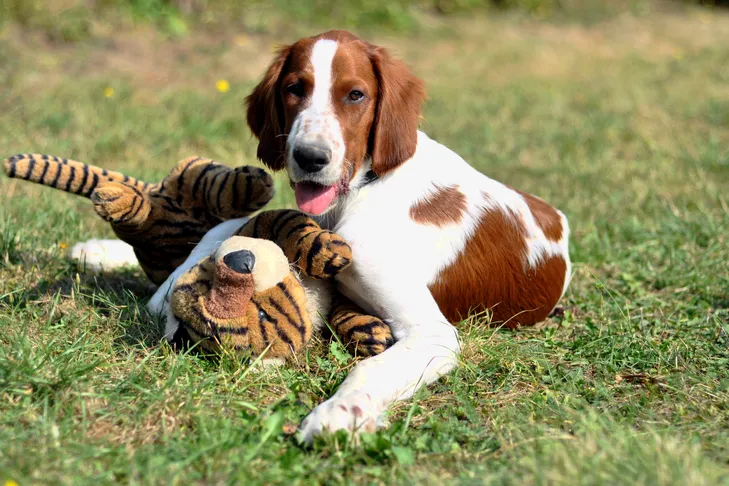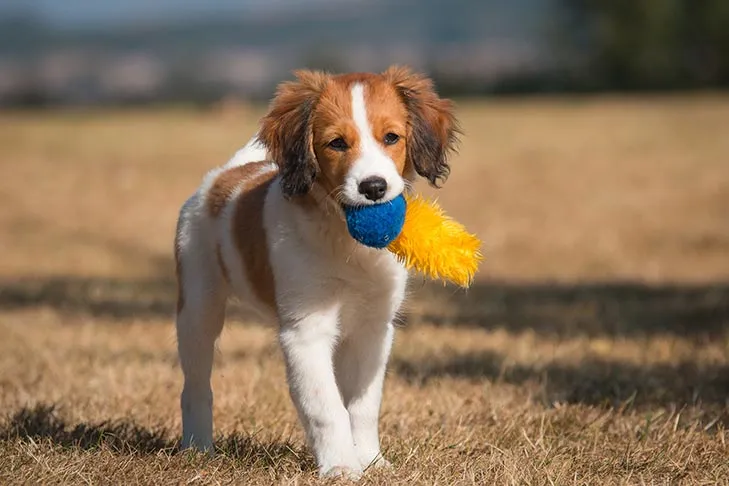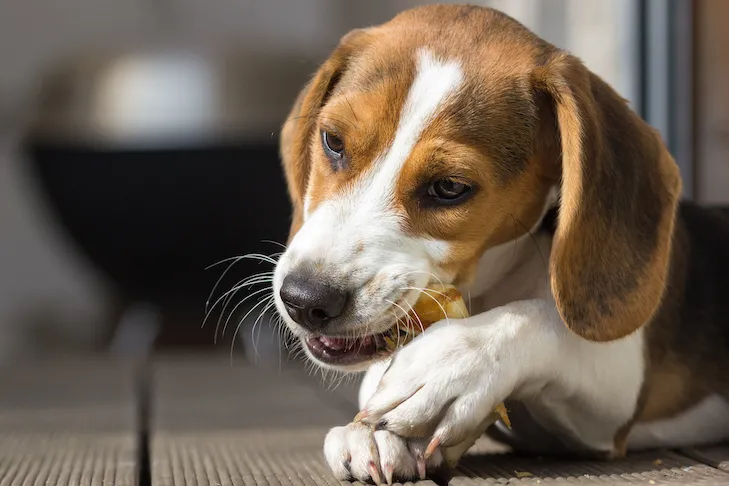Bringing a large puppy into your home is an exciting time filled with boundless energy and adorable antics. However, as any experienced owner knows, large breed puppies have unique needs, especially when it comes to their chewing habits. They grow quickly and possess strong jaws that can turn ordinary household items into chew toys in a matter of minutes. Investing in the Best Chew Toys For Large Puppies is not just about entertainment; it’s crucial for their development, mental stimulation, and preventing destructive behavior.
The right dog toy for your growing companion depends heavily on their individual personality and chewing style. If you have a puppy that relentlessly chews, it’s wise to invest in durable rubber toys designed to withstand rigorous play sessions. Conversely, if your puppy is particularly responsive to high-pitched squeaking sounds, toys that emit these noises might capture their attention. However, selecting the perfect toy transcends simply browsing the pet store aisles. It requires a thoughtful consideration of your puppy’s activity level, their specific chewing habits, and their breed.
Understanding the Crucial Benefits of Puppy Playtime
Puppies have a critical socialization window that typically begins around three weeks of age and extends to about 14 weeks. The interactions and experiences during this period are fundamental in building your puppy’s confidence and shaping their social behaviors throughout their life. Many new dog owners are aware of this window and often head to public dog parks to initiate socialization early. However, true socialization begins at home. Once your puppy is more confident and has reached sufficient physical maturity, activities can expand to more public settings like pet-friendly restaurants and daycare facilities. While exercise is vital for your puppy’s well-being, it’s essential not to overdo it. Excessive strenuous activity can negatively impact a puppy’s developing growth plates and potentially lead to injuries. Targeted, engaging play sessions are far more beneficial than prolonged, undirected exercise.
Remember, the advantages of playing with your puppy are mutual. It’s not solely about enhancing your dog’s confidence and character development; it’s also about fostering a strong bond of trust between you and your canine companion, which is the cornerstone of a lifelong companionship.
Soothing Gums and Developing Teeth with Teething Toys
Every puppy owner quickly learns that there’s chewing, and then there’s the intense, often frantic chewing associated with teething. Chewing is a natural behavior for dogs, serving as a method to alleviate boredom and occupy their time. Teething, however, is a distinct phase where a puppy’s sore gums and emerging teeth can become incredibly uncomfortable, driving them to chew on virtually anything available – from the legs of dining tables to drywall.
When selecting a teething toy for your large puppy, prioritize options that offer both comfort and engaging entertainment. Toys crafted from durable nylon or hard rubber are excellent choices. These robust materials are less likely to break apart after just a few play sessions and can effectively redirect your puppy’s discomfort away from your furniture. Exploring best chew toys to keep puppies busy can provide a good starting point for identifying suitable teething options.
 Irish Red and White Setter laying in the grass with a stuffed toy.
Irish Red and White Setter laying in the grass with a stuffed toy.
Engaging Minds with Puzzle Toys for Mental Stimulation
Dr. Stanley Coren, author of the renowned book “The Intelligence of Dogs,” posits that a dog’s intelligence is influenced by both breed (approximately 51%) and environmental factors (49%). This highlights that while breed plays a significant role, environmental enrichment is equally crucial for cognitive development. Therefore, it’s never too early to begin stimulating your puppy’s brainpower. Puzzle toys, which challenge dogs to find hidden treats or locate specific toys, offer an excellent opportunity for them to explore their surroundings and hone their problem-solving skills.
Consider puzzle toys featuring pull-out drawers, sliders, or rotating components that can be filled with high-value treats. This added incentive can significantly increase your puppy’s engagement. Some puzzle toys also incorporate auditory features like rattlers and squeakers, and remarkably, some even allow you to record your own voice to offer personalized encouragement. Since many puzzle toys come in varying difficulty levels, opt for a toy that allows you to adjust the challenge based on your puppy’s evolving abilities. What may initially take your large puppy hours to solve can soon become a quick, satisfying accomplishment. For puppies prone to destructive chewing, toys that require problem-solving can be incredibly effective.
Providing Comfort and Security with Soft Toys
In the initial days and weeks after welcoming a new puppy home, it’s natural for them to miss their mother and littermates. This can manifest as whining, pacing, and other signs of distress. Fortunately, numerous toys are specifically designed to help your puppy adjust to their new environment. For instance, some plush toys emit a sound akin to a mother’s heartbeat, aiding them in sleeping through the night. Other comfort toys include plushies with beads that can be warmed in a microwave, offering a soothing, comforting heat.
If your puppy struggles with nighttime sleep, experiences separation anxiety, or needs assistance acclimating to a new setting, a specially designed comfort toy can be invaluable. These toys can also be beneficial when crate training, helping to create a positive association with their den. You might find best chew toys for new puppies also include options that offer a sense of security.
 Nederlandse Kooikerhondje puppy outdoors with a toy in its mouth.
Nederlandse Kooikerhondje puppy outdoors with a toy in its mouth.
While these toys can provide much-needed comfort, it’s advisable to supervise their use, especially with large, energetic puppies. If your puppy relies on a toy with an artificial heartbeat for sleep, remove it once they are sound asleep to prevent them from chewing on it.
Dental Health Toys: Beneficial, but Not a Replacement for Brushing
Puppies can also greatly benefit from dental toys, which contribute to promoting good oral hygiene and preventing dental diseases. Look for dental toys featuring ridges or uneven surfaces; these textures are effective in dislodging food particles trapped between your young dog’s teeth, thereby preventing decay and that notorious “puppy breath.” Many best dog chew bones for puppies also incorporate dental benefits. You can also find flavored dental toys that actively encourage your dog to chew. Some toys are designed to accommodate dental treats, though these are typically sold separately. As with any toy your puppy will gnaw on, prioritize durable materials that are resistant to breakage. If you notice any rips, tears, or deep punctures, discard the toy immediately to prevent your puppy from ingesting small, potentially hazardous pieces.
 Young beagle chewing on a dog dental treat
Young beagle chewing on a dog dental treat
Essential Supervision During Playtime
Even if your puppy has played with a particular toy numerous times without issue, it is always a wise practice to supervise their playtime. Large puppies possess sharp teeth, and what begins as a playful session could inadvertently lead to a veterinary visit if a toy breaks apart. Even a seemingly minor puncture in a toy can release foam, stuffing, or other materials, posing a significant risk of bowel obstruction.
Supervising your puppy’s play sessions also presents an excellent opportunity to reinforce basic commands like “leave it,” “drop it,” and “come here.” Plus, can you think of anything more heartwarming than watching a playful puppy? For those with particularly strong chewers, exploring best toys for heavy chewing puppies is highly recommended.
Conclusion: Choosing Wisely for Your Growing Companion
Selecting the best chew toys for large puppies is a critical aspect of responsible pet ownership. It ensures their safety, supports healthy development, and prevents the redirection of natural chewing instincts towards your belongings. By understanding your puppy’s individual needs, considering their breed characteristics, and opting for durable, mentally stimulating, and safe toys, you can provide them with countless hours of healthy entertainment and contribute significantly to their overall well-being. For specific breed recommendations, you might find guides on best chew toys for pug puppies helpful, illustrating how toy choices can be tailored. Always prioritize toys made from non-toxic, durable materials and remember that regular inspection and replacement of worn-out toys are paramount to your puppy’s safety.
